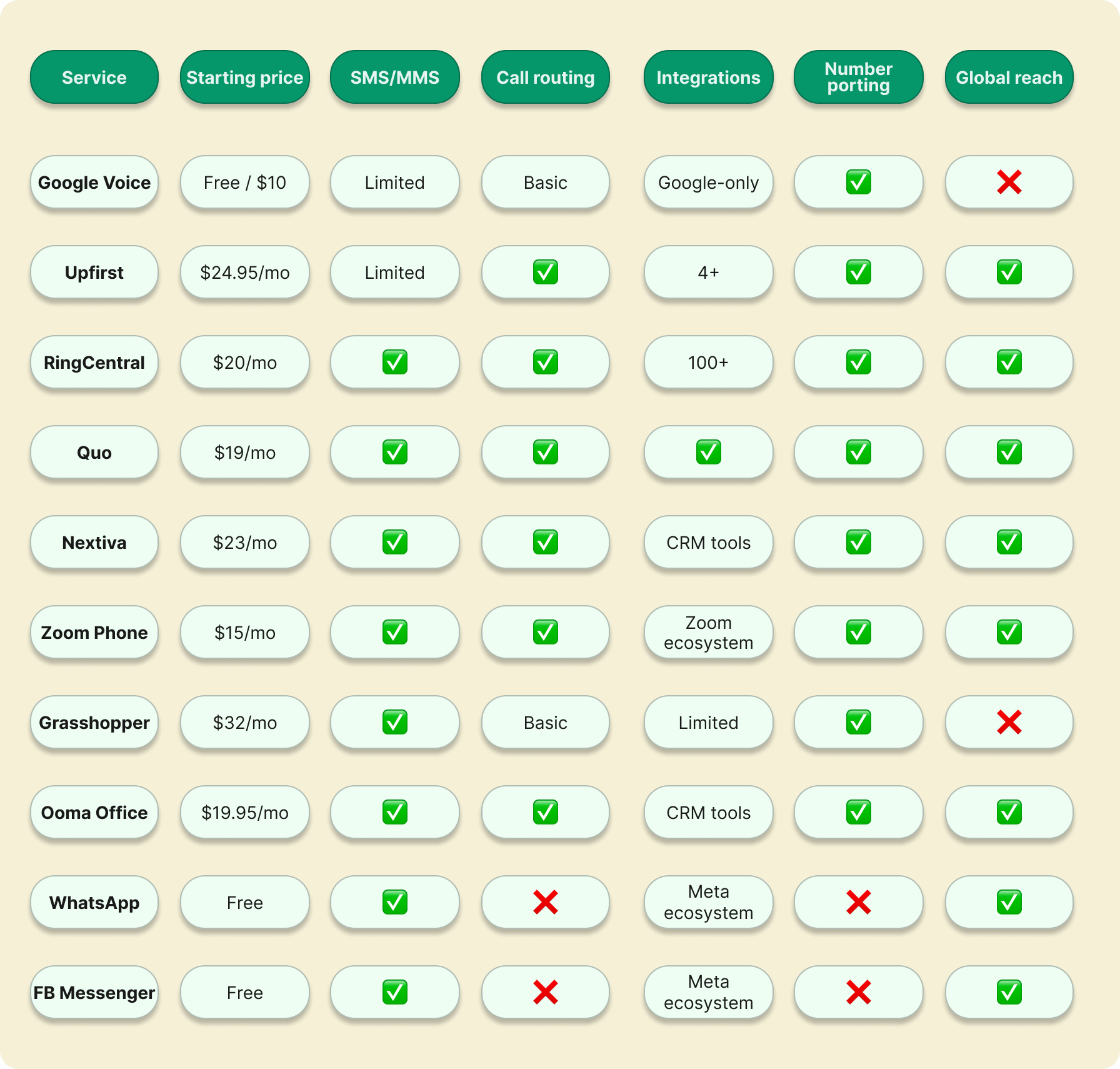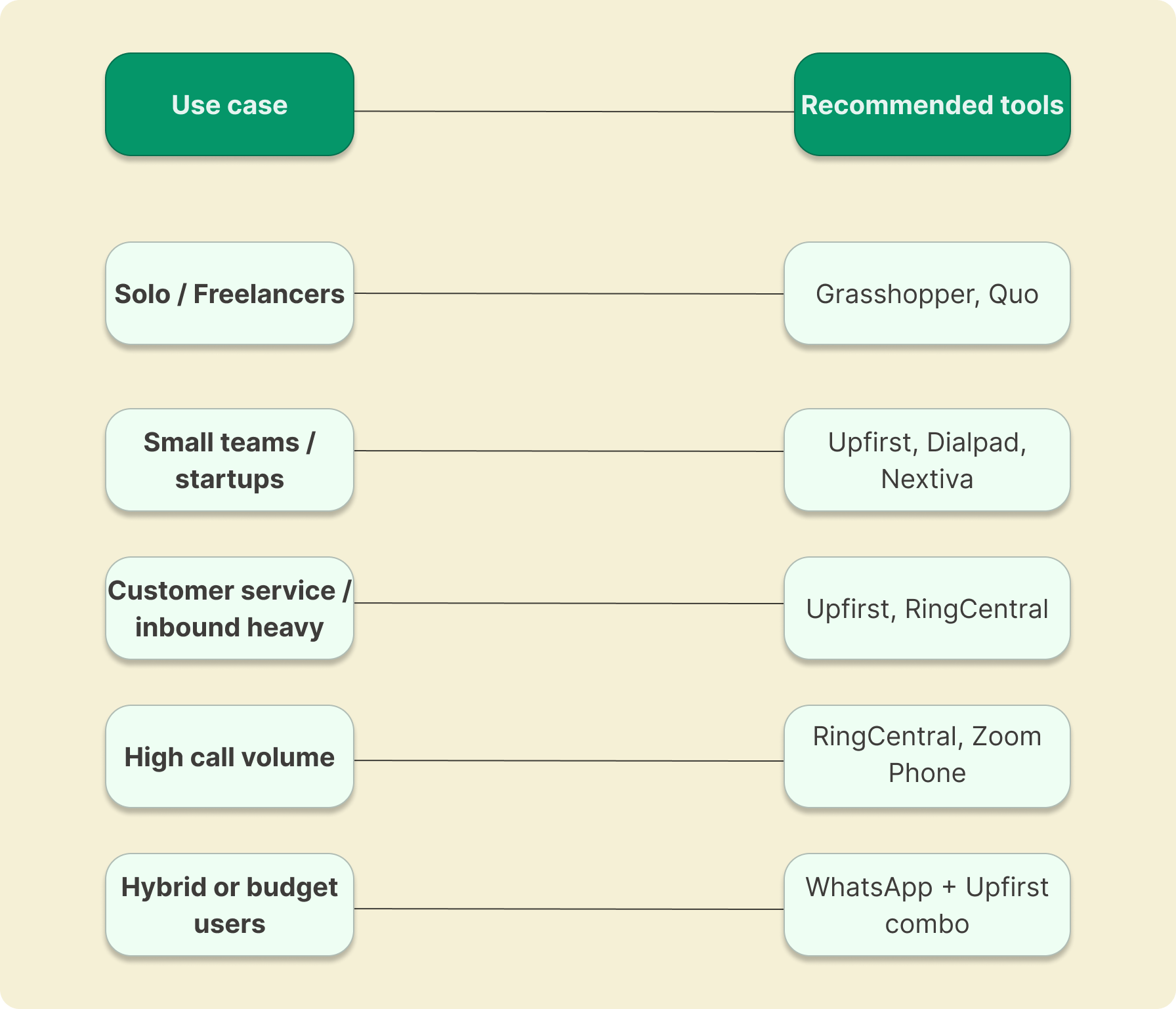- Google Voice es ideal para empezar, pero carece de funciones avanzadas como enrutamiento de llamadas, integraciones y soporte multiusuario a medida que tu empresa crece.
- Hay muchas alternativas a Google Voice, como Upfirst, RingCentral y OpenPhone, que ofrecen más flexibilidad, automatización y confiabilidad.
- Puedes cambiar fácilmente de Google Voice o incluso desviar tus llamadas a un nuevo servicio como Upfirst sin perder tu número actual.
If you’ve been using Google Voice, you already know it’s a handy, free way to get a business number, send texts, and handle calls from just about anywhere. It's a hard service to beat. But as your business grows, you might start to notice its limits.
Maybe you need better call routing. Maybe you want a dedicated customer support line. Or maybe you’ve realized Google Voice doesn’t work outside the U.S.
In this guide, we’ll walk you through the best Google Voice alternatives in 2025—including both paid and free options, and how to switch without any hurldes in your business. You’ll also see why services like Upfirst, RingCentral, and OpenPhone are becoming favorites for small businesses.
Why business owners look for Google Voice alternatives
Google Voice is simple and convenient, but it wasn’t built to be a full-featured business phone system. As your business (and team) grows, you might run into some hurdles:
- Only for U.S. users — Google Voice still isn’t available worldwide.
- Limited team features — Sharing numbers or setting up extensions isn’t easy.
- Basic texting — Sending lots of texts or integrating with other tools can be tough.
- No advanced call routing — You can’t direct calls by department, time, or location.
- Few integrations — It doesn’t sync well with popular business platforms or CRMs.
If you’ve missed important calls, struggled to forward messages, or lost voicemails, it might be time to consider switching to something more robust.
What to look for in a replacement
Before choosing a Google Voice alternative, take a moment to think about your business’s needs. Here’s a simple checklist to help you decide:
- Call quality and reliability – Clear calls, no dropped connections.
- Text messaging support – Easy business texting (SMS/MMS).
- Call routing/IVR – Send callers to the right person or department automatically.
- Integrations – Works with tools you already use, like Google Workspace or Slack.
- Multi-user support – Makes teamwork and call transfers simple.
- Pricing – Grows with your business, not your expenses.
- Number porting – Lets you keep your current business number.
Once you know what matters most, you’ll have an easier time finding the best Google Voice alternative for your business.
Best alternatives to Google Voice (paid & free)
Here are ten excellent Google Voice competitors, including AI phone assistants and free messaging tools.
1. Upfirst — Best Google Voice alternative for businesses that want an AI voice front line
What it is: Upfirst is an AI-powered answering and virtual receptionist service that handles your inbound calls 24/7. It can answer, filter, forward, and even book appointments, acting as your always-available front desk.
Why it’s better: With Upfirst, you get total control over your business calls without hiring extra staff. You can customize how it responds, set up a general caller intake for qualifying leads, intelligently route calls to the right person or department, transfer calls to you, filter out spam calls, and even let it book appointments for you. It's like having a dedicated receptionist minus the costs, which makes it an affordable option for small businesses to be able to answer every call.
Pricing: Starts at $24.95/month for 30 calls.
Best for: Businesses that want to stop missing calls without overhauling their phone setup.
Where it won't work for you: If you need an all-in-one type of communication platform that also lets you send and receive text messages, then this isn't for you.
2. RingCentral — Best full-featured Google Voice replacement
Why it’s better: RingCentral gives you a complete business phone system—including call routing, analytics, team messaging, and even video meetings. It’s built for larger teams but easy enough for any business to use.
Pricing: Starts around $20/user per month.
Best for: Businesses that want advanced VoIP features and rock-solid reliability.
Where it won’t work for you: If you’re a solo business owner or want something lightweight and budget-friendly, RingCentral might feel like overkill. It’s powerful—but built more for teams that need enterprise-grade communication tools.
3. Quo (formerly OpenPhone) — Best all-in-one communications platform for small business
Why it’s better: OpenPhone is simple, affordable, and designed for small teams. Share phone numbers, automate messages, and connect with tools like Slack or HubSpot.
Pricing: From $19/month per user.
Best for: Startups and small businesses looking for easy, shared communication.
Where it won’t work for you: If your business depends on advanced call analytics, IVR menus, or complex routing setups, OpenPhone might be too simple. It’s best suited for teams that just need a clean, modern way to talk and text.
4. Nextiva — Best for remote teams
Why it’s better: Nextiva brings together calling, texting, and CRM tools in one place. Perfect for remote teams managing customer support or sales from anywhere.
Pricing: Starts at $23/month per user.
Best for: Teams that need to collaborate and stay connected, no matter where they are.
Where it won’t work for you: If you’re looking for a quick setup or minimal interface, Nextiva can feel a bit heavy. It’s feature-packed but may take extra time to configure and train your team on.
5. Dialpad — Best AI-enhanced business phone system
Why it’s better: Dialpad uses AI to transcribe calls, summarize conversations, and highlight important details. It’s like having built-in analytics for every call.
Pricing: From $23/month per user.
Best for: Businesses that want insights and automation with every conversation.
Where it won’t work for you: If you only need basic calling and texting, Dialpad’s AI and analytics tools may be more than you need—and you’ll end up paying for features you rarely use.
6. Zoom Phone — Best for teams already using Zoom
Why it’s better: Already using Zoom for video meetings? Zoom Phone lets you handle business calls and texts right from the same platform.
Pricing: Starts at $15/user per month.
Best for: Teams that rely on Zoom and want all-in-one communication.
Where it won’t work for you: If your team doesn’t already use Zoom, adding it just for phone calls can feel unnecessary. It shines when paired with Zoom Meetings, but less so as a standalone system.
7. Grasshopper — Best for solo entrepreneurs
Why it’s better: Grasshopper keeps things straightforward. Get multiple extensions, call forwarding, and business texting—all from your cell phone.
Pricing: Starts around $32/month.
Best for: Freelancers and business owners who want a professional number on the go.
Where it won’t work for you: If you have a growing team or need features like call analytics or integrations, Grasshopper may not scale well. It’s designed for one-person or small operations.
8. Ooma Office — Best for cost-conscious businesses
Why it’s better: Ooma gives you reliable VoIP calling, voicemail, and extensions—all at a budget-friendly price.
Pricing: From $19.95/month per user.
Best for: Businesses looking for traditional VoIP without breaking the bank.
Where it won’t work for you: If you want deep integrations or mobile-friendly team messaging, Ooma’s traditional VoIP setup might feel dated. It’s reliable but not particularly flexible.
9. WhatsApp for Business — Free option for customer messaging
Why it’s better: WhatsApp for Business lets you message customers, share media, and even make calls—all for free. It’s great if your customers already use WhatsApp.
Pricing: Free (paid API plans available if you need more).
Best for: Local businesses and service providers who communicate over WhatsApp.
Where it won’t work for you: If you need a real phone number that customers can call or text from any carrier, WhatsApp won’t fit. It only works app-to-app within the WhatsApp ecosystem.
10. Facebook Messenger — Free chat and calling for small operations
Why it’s better: Messenger makes it easy to chat or call customers right from your Facebook Page or Instagram. While it doesn’t use phone numbers, it’s perfect for quick, social media-based support.
Pricing: Free.
Best for: Businesses with a strong Facebook presence who help customers via social.
Where it won’t work for you: If your business doesn’t rely on Facebook or Instagram for communication, Messenger won’t add much value. It lacks true phone functionality and requires customers to message you through social channels.
Feature comparison table

Absolutely free alternatives (beyond paid tools)
Not ready to invest in a full phone system? Here are some free Google Voice alternatives you can try:
- WhatsApp for Business – Great for messaging and calling existing contacts.
- Facebook Messenger – Free chat and voice/video calls with your social followers.
- Skype – Free calls between Skype accounts.
- Linphone – Open-source app for free VoIP calling.
- Jami – Peer-to-peer calling and messaging platform.
Note: These are free, but they do have some limitations. Most won’t let you port your number or take calls from landlines.
How to migrate or switch from Google Voice
Switching from Google Voice is pretty straightforward, but a few steps will help ensure a smooth transition:
- Unlock your Google Voice number – Head to your Google Voice settings and pay the small unlocking fee.
- Pick your new provider – Choose your preferred alternative (like Upfirst or OpenPhone).
- Start the porting process – Share your number and account details with your new provider.
- Forward calls during transition – Keep both systems active for a few days so you don’t miss anything.
- Test everything – Make sure calls, texts, and voicemails work before shutting off Google Voice.
You don't have to port your number away from Google Voice
You don't have to migrate and port a number away from Google Voice, but if you want to use something like Upfirst's AI phone answering service, you can simply forward your calls to your Upfirst receptionist.
You can even set it up so that calls are only forwarded during certain business hours, if you don't pick up the call, or forward every inbound call. That way, you can keep messaging and make outgoing calls from the platform, but you can ensure that call is answered by an inbound answering service.
Best alternative by use case

FAQs
Can I keep my Google Voice number?
Yes! Most providers let you port your Google Voice number once you’ve unlocked it in your Google settings.
Are any of these tools completely free?
Yes—WhatsApp, Facebook Messenger, and Skype are free, but they don’t offer full business phone features.
Do these alternatives support SMS/MMS?
Most paid options do. Free choices like WhatsApp or Messenger only work for app-to-app messaging.
Which options work outside the U.S.?
Upfirst, RingCentral, Dialpad, Zoom Phone y OpenPhone se pueden usar internacionalmente.
¿Cómo gestiono las llamadas de emergencia?
Algunos servicios de VoIP ofrecen cobertura E911. Por lo general, las aplicaciones gratuitas no lo hacen. Comprueba los detalles de tu proveedor para estar seguro.
Conclusión y recomendaciones
Google Voice es fantástico para empezar, pero no siempre puede seguir el ritmo a medida que tu empresa crece. Si necesitas mejores herramientas de enrutamiento de llamadas, análisis o servicio al cliente, estas alternativas de Google Voice te brindarán más flexibilidad y control.
¿Quieres una forma sin intervención de asegurarte de que todas las llamadas sean respondidas? ¿Es el primero es una excelente actualización: puedes probarla en cuestión de minutos, con planes a partir de solo 24,95$ al mes.
¿Tienes un presupuesto ajustado? Conserve su número de Google Voice o combine una herramienta gratuita (como WhatsApp o Messenger) con un servicio profesional como Upfirst u OpenPhone. De esta forma, obtendrás mensajería gratuita y una cobertura confiable de llamadas de negocios.
¿Estás listo para detener las llamadas perdidas?
👉 Prueba Upfirst gratis hoy y compruebe lo sencillo que es asegurarse de que cada llamada sea siempre respondida por una voz amable.
Nick Lau is a copywriter and content lead for Upfirst.ai. A self-starter at heart, he dove into marketing in 2015 by launching an e-commerce company, selling private-labeled products on Amazon and Shopify. When he’s not crafting copy, you might spot him on a winding road trip to the coasts or through forests, in search of unexplored places.








